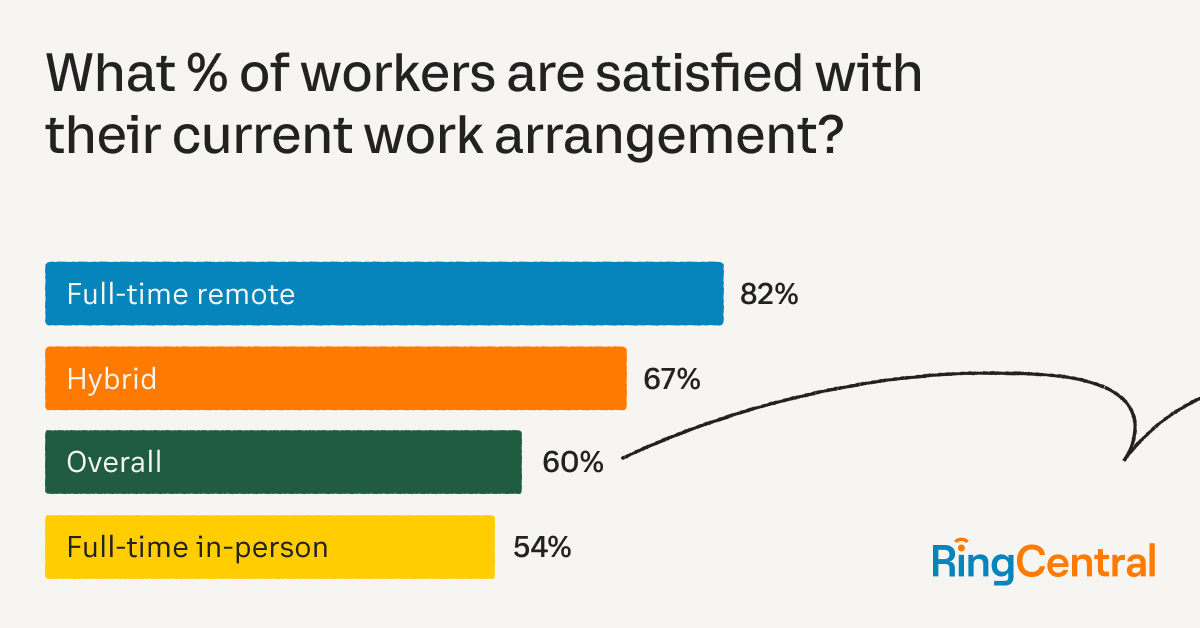It’s no big secret that many organisations have adopted new working models in times of late. And with any great workplace shift comes the need for great evolution. Understandably, leaders are figuring out how to keep employees connected and thriving in this brave new world. For businesses to succeed, team collaboration as we know it needs to be reinvented.
So, how can you get started with this reinvention and why is it so important? Our new research will give you some indication.
Here is what I’m going to cover:
- How people prefer to work today
- Why team collaboration matters
- The difference between teamwork and collaboration
- Where people do their best work
- 6 ways to boost collaboration
How do people prefer to work?
RingCentral’s research shows that there’s been an uptick in hybrid working amongst UK information workers. 47% are now working hybrid, compared to 17% the previous year. On top of this, there wasn’t a mass return to full-time in-person working after the pandemic, as some may have predicted. In fact, this way of working has only increased slightly from 29% in 2021 to 37% in 2022.
But how exactly do people feel about the way they work? According to the findings, almost a quarter (22%) of full-time office-based workers feel burned out. Our findings reinforce this negative sentiment around full-time office work. Hybrid workers and remote workers are much happier than those working full-time in-person (67% and 82% respectively, compared to 54%).
See a chart of the stats here:
What do these feelings tell us about team collaboration?
Let’s dig a bit deeper. While the research paints a positive overall picture of hybrid and remote working, 44% of full-time remote workers say they can sometimes feel isolated. Plus, around a third of remote and hybrid workers say they work longer hours and take fewer breaks because they worry about what their boss or colleagues think of them.
This suggests that, while people are happy with hybrid and remote overall, more trust and closer relationships must be established between colleagues and managers. We build trust by forming deeper connections with one another. That is exactly why building (or reinventing) team collaboration should be one of your top priorities this year.
Where do people do their best work?
All the existing working models have benefits and challenges. Here’s a summary of the good and the not-so-good.
Full-time in the office: The verdict
Office work came out as the best option for feeling connected with co-workers. 38% of all workers felt that camaraderie and impromptu chats with colleagues were key benefits of office work, and 36% even said that interacting with co-workers in person was good for their mental health. However, the key downsides were the commute and the noise and distractions of the office.
As 32% of workers prefer to be in the office for only a few days a week, full-time in-person is only sometimes the best option.
Hybrid and remote work: The verdict
On the other hand, remote and hybrid work’s top benefits were saving money, having a better work-life balance and saving time by not commuting daily.
Here’s the breakdown of those positives:
Despite the clear benefits, the numbers tell us that remote working can cause employees to fear missing out on career progression, simply for being out of sight, out of mind, and remote working means they do miss out on connecting on a human level, often impacting mental health.
You can see there are pros and cons across the lot. But the true sign of people’s best work (and therefore good collaboration) is good productivity. Hybrid workers are more likely to say that they feel more productive, 11 percentage points higher than full-time office-based workers.
In essence, employers need to strike the right balance. Allowing workers the flexibility of a quiet, focused space and an ‘open door’ to the office to support meaningful workplace connections will be key in 2023.
Before we look at ways to use these findings to tackle collaboration, let’s go back to basics.
What is collaboration? Is it the same as teamwork?
You’ve probably used this word a lot, but have you thought much about what workplace collaboration is made up of? And do you consider it to be the same as teamwork, or different? Let’s look at some definitions:
- Collaboration – the action of working with someone to produce something.
- Teamwork – the collective action of a group, especially when effective and efficient.
They sound similar, but there are some subtle differences. In a collaborative situation, group members are equal, and no leader exists. They think together and work together. Collaborators have to be creative, trust each other, respect the opinions of others, negotiate and be flexible.
For teamwork, however, there usually is a leader directing the actions of the group. Team members are allocated specific roles and work as individuals on these. They all contribute to the outcome by completing their specific task.
6 ways to boost team collaboration

Here are some of the ways you can start to reinvent collaboration and encourage more meaningful connections:
1. Communicate and evaluate your workplace regularly
Your workplace model might work wonders for your productivity and employee engagement now. But you need to regularly communicate and tap into worker sentiment and other metrics to stay aware of how well your collaborative model is working. For example, bear in mind that younger workers are leading the quiet quitting trend, with more than 40% of workers identifying themselves as quiet quitting in the US, UK, Australia and France. It’s important to listen to workers regularly. Consider an employee engagement survey to ensure there are no nasty surprises regarding employee churn.
2. Cultivate a work environment of trust and flexibility
Around a third of remote and hybrid workers say they work longer hours and take fewer breaks because they worry about what their boss or colleagues think of them. That means managers and bosses need to harness trust and flexibility. Micromanagement has no place in an effective hybrid workplace, so working on real human connection and trust is necessary if business leaders want to drive better holistic health, productivity and engagement.
3. Be mindful of where working tasks are best performed
While allowing workers to choose their location is tempting, there could be tasks that are better suited for in-person collaboration or home working. For example, information workers are more likely to believe presenting and collaborating are better suited for an in-person environment, while challenging tasks and creative thinking are better when done remotely.
4. Keep tabs on employee progression
Be aware that those who work remotely, or even those who work mostly from home as hybrid workers, could feel they might miss out on progression opportunities. Hiring from within and ensuring that managers keep tabs on their team’s professional development prevents workers from feeling undervalued or underappreciated as part of a collaborative team.
5. Kick-off team building activities (this should be a staple)
Camaraderie with colleagues is the aspect of in-office work employees like most, as voted by 38% of employees in the UK. Whether it’s coming together for a summer party, a pub quiz, or regular away days, it’s important to arrange this stuff for your team to have those informal moments. Team building can hugely improve the effectiveness of your workplace collaboration, as it creates better bonds between colleagues.
6. Use dedicated tools
Different roles within your team will have varying communications needs. But for the most part, collaborative work requires dedicated communications tools. To avoid people wasting time switching between communication applications, you should invest in one comprehensive, unified solution that helps users collaborate across different channels efficiently.
The bottom line: Consider what’s right for your business
While the research gives a steer on how the UK workforce feels (and why people prefer hybrid work) this isn’t going to be exact for all businesses. So, track your employees’ feelings about their current work arrangements if that’s something you have yet to do. Once you have a clear idea of sentiment, you’ll have all you need to invest in collaboration in the right way.
Originally published Jan 25, 2023






